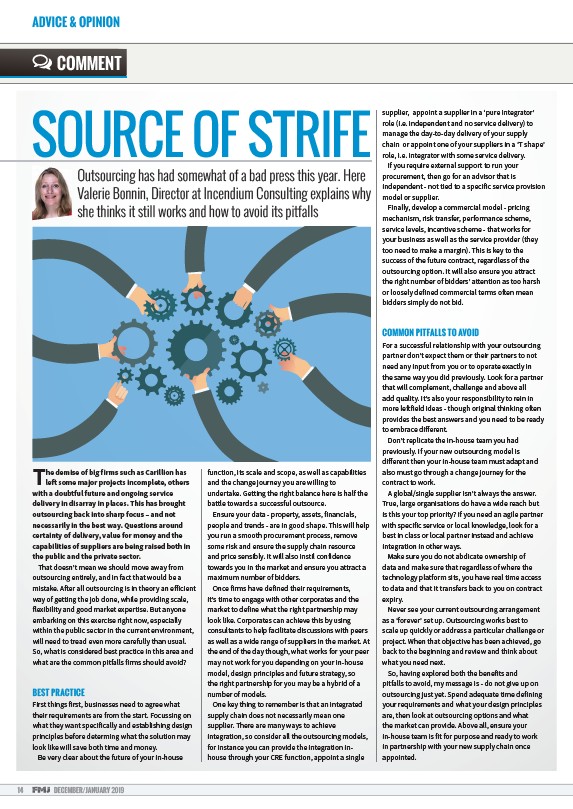
ADVICE & OPINION
COMMENT
SOURCE OF STRIFE
The demise of big firms such as Carillion has
le some major projects incomplete, others
with a doubtful future and ongoing service
delivery in disarray in places. This has brought
outsourcing back into sharp focus – and not
necessarily in the best way. Questions around
certainty of delivery, value for money and the
capabilities of suppliers are being raised both in
the public and the private sector.
That doesn’t mean we should move away from
outsourcing entirely, and in fact that would be a
mistake. A– er all outsourcing is in theory an e— icient
way of getting the job done, while providing scale,
flexibility and good market expertise. But anyone
embarking on this exercise right now, especially
within the public sector in the current environment,
will need to tread even more carefully than usual.
So, what is considered best practice in this area and
what are the common pitfalls firms should avoid?
BEST PRACTICE
First things first, businesses need to agree what
their requirements are from the start. Focussing on
what they want specifically and establishing design
principles before determing what the solution may
look like will save both time and money.
Be very clear about the future of your in-house
14 DECEMBER/JANUARY 2019
function, its scale and scope, as well as capabilities
and the change journey you are willing to
undertake. Getting the right balance here is half the
battle towards a successful outsource.
Ensure your data - property, assets, financials,
people and trends - are in good shape. This will help
you run a smooth procurement process, remove
some risk and ensure the supply chain resource
and price sensibly. It will also instil confidence
towards you in the market and ensure you attract a
maximum number of bidders.
Once firms have defined their requirements,
it’s time to engage with other corporates and the
market to define what the right partnership may
look like. Corporates can achieve this by using
consultants to help facilitate discussions with peers
as well as a wide range of suppliers in the market. At
the end of the day though, what works for your peer
may not work for you depending on your in-house
model, design principles and future strategy, so
the right partnership for you may be a hybrid of a
number of models.
One key thing to remember is that an integrated
supply chain does not necessarily mean one
supplier. There are many ways to achieve
integration, so consider all the outsourcing models,
for instance you can provide the integration inhouse
through your CRE function, appoint a single
supplier, appoint a supplier in a ‘pure integrator’
role (i.e. independent and no service delivery) to
manage the day-to-day delivery of your supply
chain or appoint one of your suppliers in a ‘T shape’
role, i.e. integrator with some service delivery.
If you require external support to run your
procurement, then go for an advisor that is
independent - not tied to a specific service provision
model or supplier.
Finally, develop a commercial model - pricing
mechanism, risk transfer, performance scheme,
service levels, incentive scheme - that works for
your business as well as the service provider (they
too need to make a margin). This is key to the
success of the future contract, regardless of the
outsourcing option. It will also ensure you attract
the right number of bidders’ attention as too harsh
or loosely defined commercial terms o– en mean
bidders simply do not bid.
COMMON PITFALLS TO AVOID
For a successful relationship with your outsourcing
partner don’t expect them or their partners to not
need any input from you or to operate exactly in
the same way you did previously. Look for a partner
that will complement, challenge and above all
add quality. It’s also your responsibility to rein in
more le– field ideas - though original thinking o– en
provides the best answers and you need to be ready
to embrace di— erent.
Don’t replicate the in-house team you had
previously. If your new outsourcing model is
di— erent then your in-house team must adapt and
also must go through a change journey for the
contract to work.
A global/single supplier isn’t always the answer.
True, large organisations do have a wide reach but
is this your top priority? If you need an agile partner
with specific service or local knowledge, look for a
best in class or local partner instead and achieve
integration in other ways.
Make sure you do not abdicate ownership of
data and make sure that regardless of where the
technology platform sits, you have real time access
to data and that it transfers back to you on contract
expiry.
Never see your current outsourcing arrangement
as a ‘forever’ set up. Outsourcing works best to
scale up quickly or address a particular challenge or
project. When that objective has been achieved, go
back to the beginning and review and think about
what you need next.
So, having explored both the benefits and
pitfalls to avoid, my message is - do not give up on
outsourcing just yet. Spend adequate time defining
your requirements and what your design principles
are, then look at outsourcing options and what
the market can provide. Above all, ensure your
in-house team is fit for purpose and ready to work
in partnership with your new supply chain once
appointed.
Outsourcing has had somewhat of a bad press this year. Here
Valerie Bonnin, Director at Incendium Consulting explains why
she thinks it still works and how to avoid its pitfalls